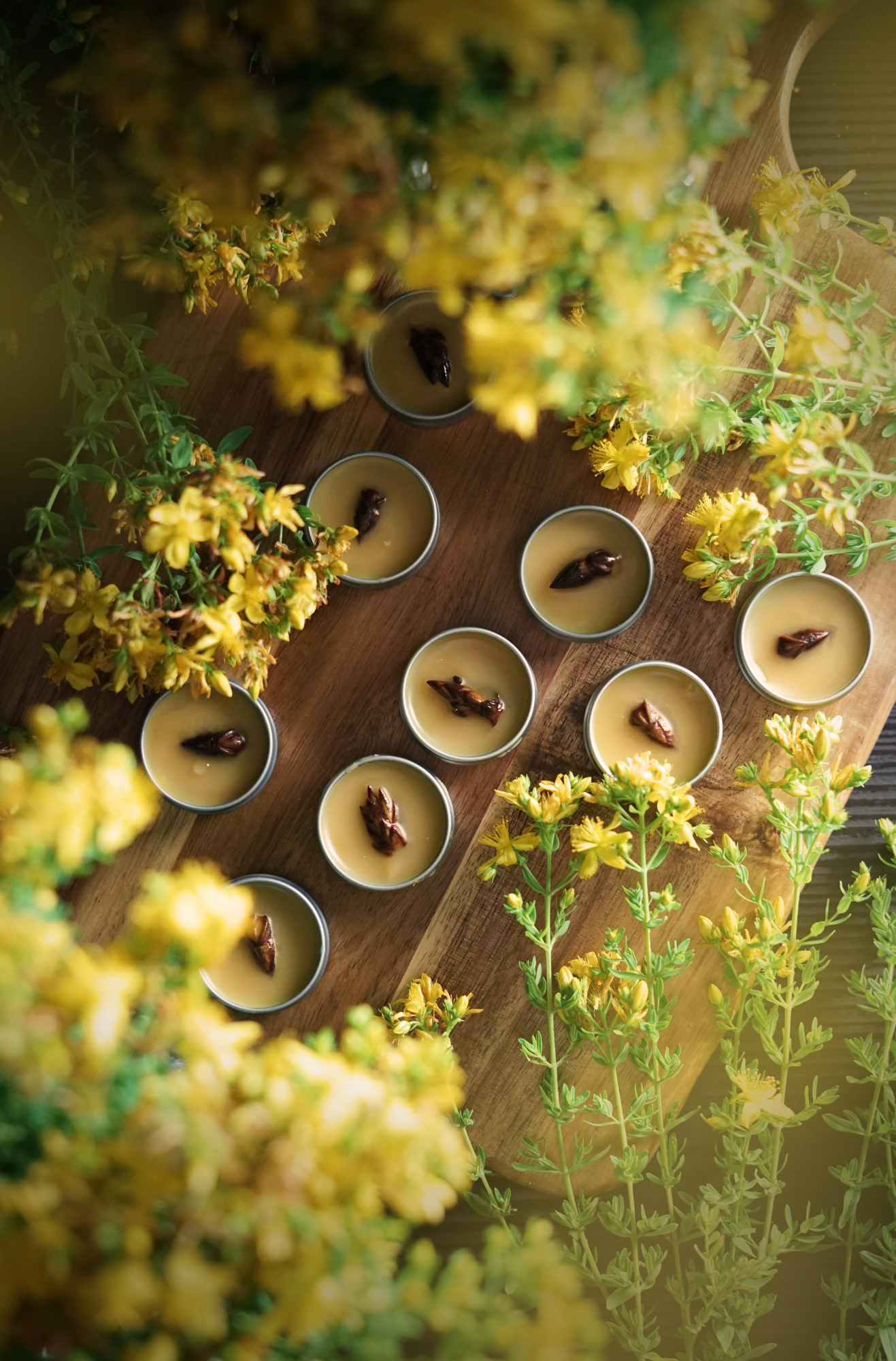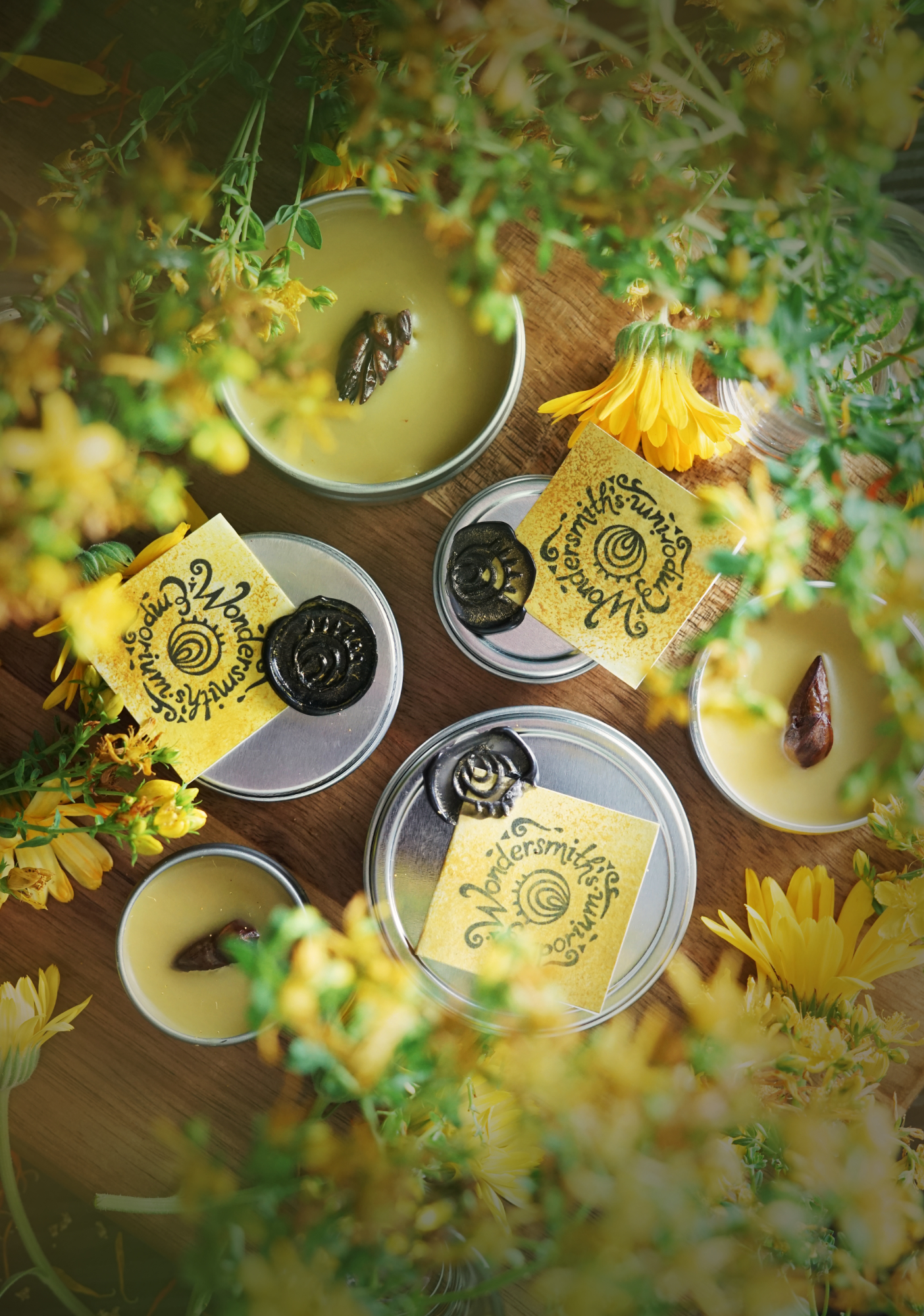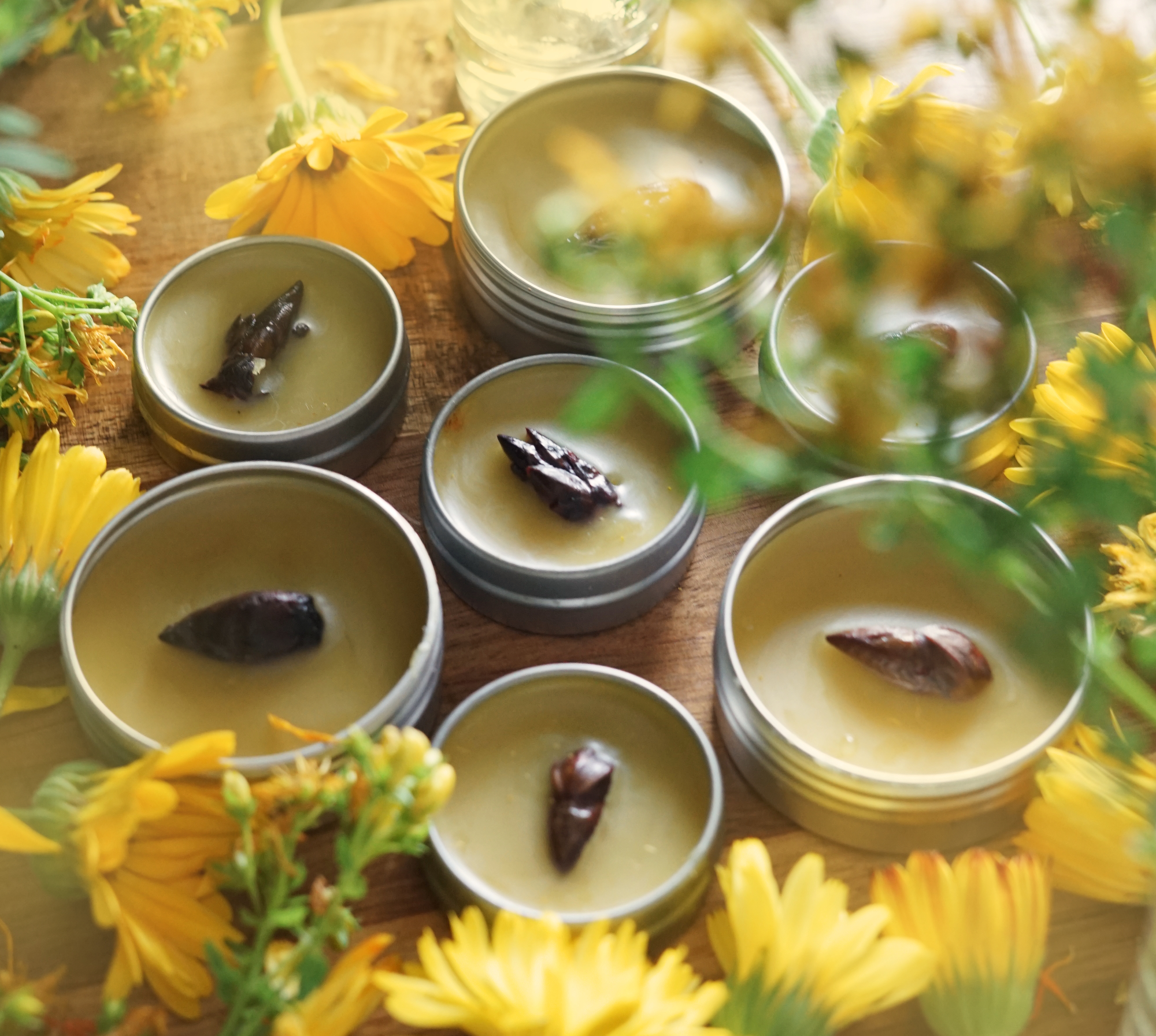Balm of Gold: Healing Summertime Sunlight
Oh what a marvelous force that glowing sun can be! After all, its golden rays are what make life on earth possible; what feeds our plants and ecosystems, what warms our landscapes, what illuminates our world. As the days reach their peak length, our focus understandably shifts to the glorious sunlight. And while it’s impossible to bottle up sunbeams to enjoy later, it’s fairly easy to bottle up some of the healing plants that it nourishes. I’m talking about Balm of Gold, a soothing salve full of summertime healing. This balm is a versatile nature first aid kit and will help treat many summertime conditions, from cuts and scrapes to rashes and burns.
This gold-colored balm is one of the most useful tools you can have in your medicine cabinet. It’s made from 3 highly medicinal plants. You’ll need to start early - cottonwood buds are collected in late January or early February in most areas in the region. Then you’ll progress throughout the year, adding calendula and St. John’s Wort later on. If you miss one of these plants, it’s okay - you can still make the balm out of the other ingredients and it will still be wonderful. You can also buy infused oils from Mountain Rose Herbs.
This also brings me to a big announcement: I'm opening an Etsy Shop! If you don't want to wait a full year to make your own Balm of Gold, you can now purchase some now at the Wondersmith's Emporium! (For a limited time, since I've only made so much.)
Okay, back to the balm:
Balms have a thicker consistency with more beeswax, while salves are a bit softer. You can make either. Balms are best for carrying around with you, since they don’t melt as easily in a backpack or pocket. They are more water-resistant and protective, making them a better barrier for cuts or scrapes. Salves are great to keep around the home and have a softer consistency, making them easier to massage into your skin. Both are healing. In this post I am going to teach you about technique rather than a specific recipe, so that you can develop your own healing balm and salve recipes as well!
Cottonwood Bud:
The first ingredient in our golden balm is cottonwood buds. These are the small, unopened buds that form on cottonwood trees in late January or early February (depending on the year and your location.) They are harvested when they are plump and full of highly-fragrant resin but haven’t started opening yet. Forage them when it’s cold out - it keeps them from being a sticky mess. It’s a good idea to wear rubber gloves as well. To make the oil, simply fill a clean glass jar 3/4 full of the freshly-gathered buds, then top the rest of the way with an oil of your choice (I prefer sweet almond oil for salves, but a light olive oil works great too.) Leave in a dark place for 3-4 months, checking and stirring every now and then. Strain, reserving the oil for the next infusion.
Cottonwood bud oil is anti-inflammatory, antimicrobial, and analgesic. You can use it on small cuts, scrapes, bumps, bruises, aches, pains, strains, and more. It is said to help relax menstrual cramps. It can even be used as an expectorant when you have a cold if you rub it on your chest. Cottonwood buds contain some salicylic acid, a natural form of aspirin which is a pain reliever for arthritic joints, injuries, tendonitis, etc. It makes a fantastic general wound salve, reducing inflammation, encouraging healing, eradicating bacteria, and tightening surrounding tissue. Cottonwood bud oil is also a natural antioxidant and preservative to make your natural salves last longer.
It also has a very long history being used as a healing salve. If you’ve read the Bible, you may be familiar with the “Balm of Gilead,” which was a rare medicinal perfume named for the region of Gilead where it was produced. It has come to signify a universal cure. It was most likely made out of poplar or cottonwood buds!
Calendula:
When calendula starts blooming in mid-May, gather the fresh petals, dry them, and make an infusion. Fill another clean jar 1/2 full of dried petals, then top with the strained cottonwood bud infusion from the previous section. Leave in a dark place to infuse for a month or two (or until the St. John’s Wort comes into season.)
Calendula oil is both gentle and very soothing. It is anti-inflammatory, anti-viral, and antispasmodic. Calendula has been traditionally used for abdominal cramps and constipation due to its gentle antispasmodic effects. It is also the go-to in herbal medicine for skin conditions. It’s particularly helpful in healing stubborn wounds, acne, ulcers, sores, rashes, psoriasis, dermatitis, eczema, varicose veins, and other sore or inflamed skin conditions such as dryness and chapping or inflammation. It’s a long-time treatment for diaper rashes. It even has anti fungal properties so it helps athlete’s foot, ringworm, and jock itch. Its antiseptic and antimicrobial effects help spread up the healing of cuts and scrapes, particularly stubborn and slow-healing cuts (many say it also helps to prevent scars by stimulating the production of collagen at wound sites.) Basically, it’s been used over the years for pretty much any and every skin condition or discomfort.
Calendula is in the Marigold family, and many say it is named for the Virgin Mary, with whom it has been associated since the 14th century. It’s used to honor Mary during Catholic events, and was also considered by ancient Egyptians to have rejuvenating properties. Hindus used the flowers in religious ceremonies as well as to color their food, fabrics, and cosmetics. “Calendual” comes from the latin word “calendae,” meaning “little calendar,” because the flower blooms on the caleds or the first of most months throughout its growing season. Calendula and marigolds have been used for many things over the years beyond the healing properties listed above. Marigolds were even included as an ingredient in many recipes for fighting the plague!
St. Johns Wort (Hypericum perforatum):
The final medicinal plant to add to our infusion is St. John’s Wort. To infuse your oil, once again fill a clean jar halfway full of fresh St. John’s Wort flowers and top with the strained calendula and cottonwood bud-infused oil. Let sit for a couple of weeks. Worth noting: when you infuse it in oil, you need to use the fresh flowers only. Dried won’t be nearly as potent.
St. John’s Wort is an amazing home remedy for minor burns. It help stop the pain, promotes faster healing, and minimizes scarring due to its anti-inflammatory effects. (Though you should never put a balm on a fresh burn for at least 24 hours so as not to trap the heat in. Always wait a day or two before applying salves or oils and don’t apply them directly to blisters or broken skin.) St. John’s Wort is also really helpful with muscle strain and tension like sore or pulled muscles or nerve pain like sciatica. It has a vulnerary action on the skin, which means it helps the skin to regenerate and heal. It is used to address viral infections like cold sores or other skin irritations like rashes or itchiness due to insect bites or stings.
St. Johns Wort often blooms around the Summer Solstice or St. John’s Day, making it a frequent choice for sacred rites and rituals this time of the year. St. John’s Wort is also a very well-known herbal treatment for depression when taken internally. It’s a strong mood stabilizer, but should always be used under the care of your doctor as it interacts with many other medications and can cause increased photosensitivity. It’s no surprise that St. John’s Wort has such a strong association with the sun - its lovely bright yellow flowers with serrated petals look like sunbursts in their own right! Another fascinating thing about this plant is that it turns tinctures and oils a rich burgundy red, not yellow. If you process it just right, you can dye fabric in three colors from a single St. John’s Wort dyebath: yellow, green, and red.
The Balm:
As you can tell from reading their descriptions, the combined oil from these three healing plants can be used for just about everything. If you’re packing one thing along in your herbal first aid kit, this is the thing to pack. Stick a jar of it in your car, your backpack, your bathroom, or anywhere else you might want to access it. This Balm of Gold is simple, natural, and incredibly effective in soothing any number of small burns, cuts, rashes, scrapes, bites, stings, or soreness. It’s also easy to make, though the infusions take some time and patience. Turning that oil into a salve or balm is also quite simple. Rather than giving you a recipe with set measurements, I am instead going to instruct you in making your own salve or balm in whatever firmness or thickness you desire. This will give you the freedom to design and make your own healing balms in the future.
The only ingredients you’ll need for your balm are an infused oil and some beeswax. You can also add a bit of Vitamin E as a preservative, but that is optional and not really necessary in this recipe since the cottonwood buds already act as an antioxidant. To make the salve, place a plate into the fridge then pour your infused oil into a double boiler set over low heat. Once the oil is warmed (it should never get hot!), begin adding the beeswax, a little at a time. Usually for 1 cup of oil, I’ll add about 2 Tbs. beeswax pellets to start. Once the beeswax has melted in, dab a tiny bit of the mixture on the chilled plate and let it set up. Poke it with your finger and analyze the consistency. Is it very soft? Somewhat set? Continue to slowly add more beeswax and test the results until you reach a consistency you are happy with. (And if you over-shoot and make it too hard, just add a bit more oil until it comes back into the range you want it to be.) Remove from heat and stir in the Vitamin E oil if you are using it. (About 2 capsules or 1/2 tsp. per 2 cups of salve is appropriate.) While the mixture is hot, pour it into small containers and allow to set completely. Your healing Balm of Gold is now ready for use!
Finally, be sure to share your bounty with others. A little salve goes a long way, and you’ll likely make more than you’ll use yourself in one year. Little tins of salve make a wonderful gift, especially for those with compromised immune systems who have difficulty with healing stubborn cuts, scrapes, or bruises. The best part about crafting wild herbal medicine is that it’s mostly free - all this project will cost you is a bottle of oil and a bit of beeswax. (And some tins, but recycled mints tins or chapstick tubes can be used for free!) Pass on the care, healing, and reverence for nature.
I hope you enjoyed this post! As always, it's thanks to the generous contributions of my Patrons that I am able to share these freely with all of you. If you'd like to pledge a small set amount per month to help me continue writing and sharing, you can do so on my Patreon page!




















Join me for a little winter night magic as we bake this cake full of rich seasonal flavors and black cocoa!